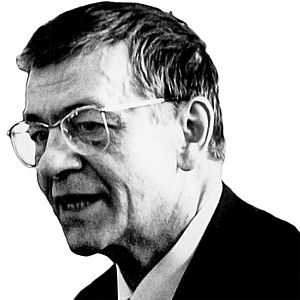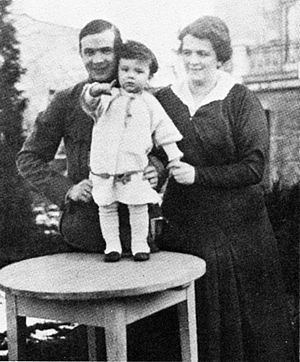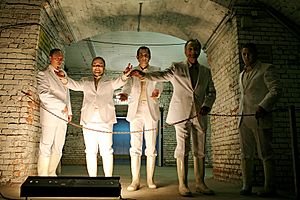Peter Weiss facts for kids
Quick facts for kids
Peter Weiss
|
|
|---|---|

Weiss speaking during the acceptance ceremony for the Bremen Literature Prize, 1982
|
|
| Born |
Peter Ulrich Weiss
8 November 1916 Nowawes, Brandenburg, Germany
|
| Died | 10 May 1982 (aged 65) Stockholm, Sweden
|
| Citizenship | Swedish |
| Alma mater | Polytechnic School of Photography; Academy of Fine Arts, Prague |
|
Works
|
Marat/Sade; The Aesthetics of Resistance |
| Movement | Avant-garde |
| Spouse(s) |
|
| Awards |
|
Peter Ulrich Weiss (born November 8, 1916 – died May 10, 1982) was a talented German writer, painter, and filmmaker. He later became a Swedish citizen. He is best known for his plays like Marat/Sade and The Investigation. His long novel, The Aesthetics of Resistance, is also very famous.
Peter Weiss became well-known after World War II. He was known for his detailed writing style and for writing about his own life. He also wrote plays that dealt with important political ideas. His play Marat/Sade was a huge success around the world. It even won a Tony Award in America and was made into a movie.
His play The Investigation was about the Frankfurt Auschwitz Trials. It helped people talk more about how to deal with the past. Many people consider his novel The Aesthetics of Resistance to be one of the most important German books of the 1970s and 80s. Peter Weiss also created surrealist paintings and experimental films when he was younger, but these are less known.
Contents
Peter Weiss's Early Life
Weiss was born in Nowawes, which is now part of Potsdam-Babelsberg, near Berlin. His father was Hungarian Jewish, and his mother was Christian. After World War I, his father became a Czech citizen, so Peter also became a Czech citizen. He was never a German citizen.
When he was three, his family moved to Bremen, a German port city. Later, as a teenager, he moved back to Berlin and started training to be a painter. In 1935, his family moved to Chislehurst, near London. There, he studied photography at the Polytechnic School of Photography.
In 1936–1937, his family moved to Czechoslovakia. Peter Weiss studied at the Prague Art Academy. When Germany took over parts of Czechoslovakia in 1938, his family moved to Sweden. Peter joined them in Stockholm in 1939. He lived there for the rest of his life and became a Swedish citizen in 1946. Peter Weiss was married three times. His last marriage was to the Swedish artist Gunilla Palmstierna-Weiss in 1964.
Speaking Out for Change
In the 1960s, Peter Weiss became more involved in politics. He supported revolutionary Cuba and spoke out against the United States' actions in Vietnam. He even visited both countries. In 1966, he visited the United States. During a meeting at Princeton University, he openly criticized the war in Vietnam.
In 1967, he took part in the Russell Tribunal in Stockholm, which was an anti-war group. In 1968, he joined the Swedish Left Party. That same year, he visited North Vietnam and wrote a book about his trip.
In 1970, Peter Weiss had a heart attack. After that, he spent ten years writing his huge three-part novel, The Aesthetics of Resistance. He also wrote two different plays based on Kafka's novel The Trial. Peter Weiss passed away in Stockholm in 1982.
Art and Writing
When Peter Weiss was a young painter, from 1930 to 1950, he was inspired by old Dutch painters like Pieter Breughel and Hieronymus Bosch. After World War II, his art, films, and writing were all influenced by Surrealism. Surrealism is an art style that uses dream-like and strange images.
He taught painting at Stockholm's People's University. He also drew pictures for a Swedish version of The Book of One Thousand and One Nights. In 1952, he joined the Swedish Experimental Film Studio. There, he made several short experimental films. He also made documentary films about social issues, like Faces in the Shadow (1956) and What Do We Do Now? (1958). In 1959, he directed his only full-length experimental film, Hägringen (The Disappeared).
In the early 1950s, Weiss started writing again. He wrote several short, intense stories, some in German and some in Swedish. These stories were often surreal and showed the influence of Kafka.
His most important early story was Der Schatten des Körpers des Kutschers (The Shadow of the Body of the Coachman, 1952). This was a very experimental book. It used strange, unsettling images to explore language. It turned a peaceful countryside scene into a nightmare. Peter Weiss also created collages for the book, similar to the artist Max Ernst. When this book was published in Germany in 1960, it made the 45-year-old writer very famous in the German literary world.
After this success, Weiss stopped painting and filmmaking. He focused only on writing. Almost all his later and most important works were written in German. His next book, Abschied von den Eltern (Leavetaking, 1959/60), was about his own life. It was very popular, as was its follow-up, Fluchtpunkt (Vanishing Point, 1962).
Famous Plays
Since the early 1950s, Peter Weiss had also been writing plays. But none of his early plays prepared people for his next work. This play was about the French Revolution and became famous overnight: "Die Verfolgung und Ermordung Jean Paul Marats dargestellt durch die Schauspielgruppe des Hospizes zu Charenton unter Anleitung des Herrn de Sade (The Persecution and Assassination of Jean Paul Marat As Performed by the Inmates of the Asylum of Charenton Under the Direction of Monsieur de Sade). People often call it Marat/Sade.
It was first performed in West Berlin in 1964 and quickly made Weiss well-known. The next year, in 1965, British director Peter Brook staged it in London. Brook's film version in 1967 made Marat/Sade a global cultural hit. The play takes place in a mental asylum and explores the role of writers during a time of revolution. It features two real historical figures: Jean-Paul Marat, a writer and leader of the French Revolution, and the Marquis de Sade, another writer who had mixed feelings about the revolution.
After Marat/Sade, Peter Weiss's work became very popular in East Germany. His plays were performed in many theaters there. Weiss often visited East Berlin and became friends with many writers and artists. Even though he was sometimes viewed with suspicion, his work was important in both East and West Germany.
In 1965, Weiss wrote the documentary play The Investigation (Die Ermittlung). This play was about the real-life Frankfurt Auschwitz Trials. Like Marat/Sade, it gained a lot of international attention. It led to many discussions about how to show the horrors of Auschwitz.
He then wrote two experimental plays about the fight for freedom in developing countries: Song of the Lusitanian Bogey (1967) about Angola, and Viet Nam Discourse (1968) about Vietnam. His next two plays were about thinkers and writers during times of change: Trotsky in Exile (1970) and Hölderlin (1971).
Between 1971 and 1981, Weiss worked on his biggest project: a three-part, 1000-page novel called The Aesthetics of Resistance. This novel was about the European resistance movement against Nazi Germany.
Peter Weiss received many awards for his work. These include the Charles Veillon Award (1963), the Lessing Prize (1965), the Heinrich Mann Prize (1966), and the Georg Büchner Prize (1982), which is Germany's highest literary award.
Selected Works
Here are some of Peter Weiss's important works:
Plays
- 1963/5 Marat/Sade (Full title: The Persecution and Assassination of Jean-Paul Marat As Performed by the Inmates of the Asylum of Charenton Under the Direction of Monsieur de Sade)
- 1965 The Investigation (Die Ermittlung)
- 1967 Song of the Lusitanian Bogey (Gesang vom lusitanischen Popanz)
- 1968 Viet Nam Discourse (Diskurs über die Vorgeschichte und den Verlauf des lang andauernden Befreiungskrieges in Viet Nam)
- 1969 Trotsky in Exile (Trotzki im Exil)
Novels and Prose
- 1952 The Shadow of the Body of the Coachman (Der Schatten des Körpers des Kutschers)
- 1960 Leavetaking (Abschied von den Eltern)
- 1961 Vanishing Point (Fluchtpunkt)
- 1975–1981 The Aesthetics of Resistance, 3 volumes (Die Ästhetik des Widerstands)
Films
- 1952 Study I (Awakening) (Studie I (Uppvaknandet))
- 1956 Faces in the Shadow (Ansikten I Skugga)
- 1959 The Disappeared (Hägringen)
Images for kids
See also
 In Spanish: Peter Weiss para niños
In Spanish: Peter Weiss para niños





